Combined Studies Approach to Rule Out Cosmological Models Which Are Based on Nonlinear Electrodynamics
Abstract
:1. Introduction
2. Nonlinear Electrodynamics Coupled to General Relativity
2.1. Modified Friedmann Equations
2.2. Cosmological Parameters
2.2.1. Energy Density Parameter
2.2.2. EOS Parameter
2.2.3. Deceleration Parameter
2.2.4. Squared Sound Speed
2.3. Statefinder Analysis
3. Stability and Causality Analysis of Several NLED Lagrangians
3.1. Power-Law NLED Lagrangian
3.2. Generalized Rational Nonlinear Electrodynamics
Generalized Rational Nonlinear Electrodynamics without Maxwell Term
4. Dynamical Systems Analysis of Models with Stable and Causal Lagrangian Density
4.1. Power-Law Lagrangian
- At the first critical point, , ordinary matter dominates (). The behavior of this critical point, as determined by the eigenvalues and , indicates that it is a decelerated () future attractor when (-stable) and a saddle point when (-unstable). The effective barotropic parameter indicates that the combined effect of ordinary matter and nonlinear radiation is such that the expansion of the universe behaves as if it is dominated by non-relativistic matter. This is consistent with a dust-dominated universe within the framework of standard cosmology. Finally, the statefinder parameters take the values and undefined. This indicates that the cosmological model exhibits characteristics of the CDM model with respect to the parameter r. However, the parameter s is undefined, so that there must be appreciable deviations from the CDM model. This reflects the influence of the nonlinear electrodynamics on the universe’s dynamics, distinguishing it from a purely matter-dominated model.
- The second point , where Maxwell radiation dominates with and , has eigenvalues and . This indicates that it is a decelerated () source (past attractor) when and a saddle point when . An effective EOS parameter indicates that the combined effect of ordinary matter and nonlinear radiation results in the expansion of the universe behaving as if it were dominated by radiation. The statefinder parameters take the values and . These values indicate significant deviations from the CDM model. These deviations reflect the nonlinear electrodynamics’ impact on the dynamics of the universe.
- For the point , where nonlinear radiation dominates , the squared sound speed is given by . The eigenvalues and indicate that this point is a future attractor if (-unstable), a saddle point if (-stable), and a source (past attractor) if (-stable if ). The deceleration parameter at this point is , which indicates an accelerated expansion if ; however, this value of the -parameter falls outside of the range where the model is stable and causal. For the expansion is always decelerated. The effective EOS parameter . The statefinder parameters for this critical point take the values and . The dependence of the statefinder parameters on reflects the impact of nonlinear electrodynamics on the dynamics of the universe, providing insights into appreciable deviations from the CDM model.
- For the dynamics of the model start from a Maxwell radiation domain (), transiently approach the matter-dominated phase (), and are finally attracted towards the nonlinear radiation domain (). The transient matter-dominated stage could explain the correct amount of structure formation. In the case when , the attractor solution depicts accelerated expansion, so that the nonlinear radiation could explain the accelerated expansion of the universe without the need for any dark energy. Unfortunately, this scenario is not physically acceptable because the values of the parameter fall outside of the range , where the model is free of gradient and tachyon instabilities.
- For , all trajectories start from the Maxwell radiation-dominated point (), then these approach to a transient stage where the nonlinear radiation dominates (), and eventually, reach the matter-dominated attractor (). The values of the statefinder parameters vary from one critical point to another. This means that the model exhibits a dynamic behavior quite distinct from the standard cosmological model, indicating that the influence of nonlinear electrodynamics introduces substantial differences in the evolution of the universe compared to a CDM framework, see the left panel of the Figure 4.
- For , the orbits in the phase space are sourced by the nonlinear radiation (), evolve transiently near the Maxwell radiation-dominated point (), and are finally attracted towards the matter-dominated point (). The values of the statefinder parameters change from critical point to critical point, for instance, at the past attractorwhile at the future attractor , undefined, and at the Maxwell point () and . These values do not closely align with the consensus CDM model, signaling appreciable departures from it, see the right panel of the Figure 4.
4.2. Generalized Rational Nonlinear Electrodynamics Dynamical Evolution without Maxwell Term
- The first critical point, , dominated by ordinary matter (), is decelerated (), and its effective barotropic parameter simulates dust (). At this point, the SSS corresponds to Maxwell radiation, meaning . The Jacobian matrix’s eigenvalues are and . This indicates that is a future attractor if and a saddle point if . The values of the statefinder parameters at this point are both positive: and . The significant deviation of s from zero indicates a considerable divergence from the standard cosmological model. This substantial positive value of s reflects a significant influence of nonlinear electrodynamics on the universe’s dynamics.
- The point corresponds to decelerated expansion as well (), and it is also dominated by ordinary matter. The effective EOS parameter means that the background fluid mimics dust. The SSS at this point is given by Therefore, the stability and causality depend on the value of , which must satisfy the condition found in the previous section: . The eigenvalues of the Jacobian matrix are and , indicating that is a future attractor if and a saddle point otherwise. The values of the statefinder parameters for this point are given by and . The parameter s varies with , indicating how the nonlinear electrodynamics affects the model’s deviation from the standard cosmological model. Specifically, the expression for s highlights the sensitivity of the model’s behavior to the parameter . Only when does the model exhibit behavior similar to CDM, where .
- The point is dominated by Maxwell radiation (), withand represents decelerated expansion (). The SSS . The eigenvalues of the Jacobian matrix at this point are and , indicating that this point acts as a past attractor if and as a saddle point for other values. For the statefinder parameters, we obtain that and . These values imply that the cosmological model at this critical point behaves very differently from the CDM model.
- For the critical point , several of the relevant cosmological parameters such as and the statefinder parameter r, are undefined. The only parameters which one can determine are and . The eigenvalues of the Jacobian matrix at this point are and , indicating that it acts as a past attractor if , otherwise it is a saddle point. These features of the NLED-based equilibrium configuration suggests that the nonlinear effects of the magnetic field play an important role in the course of cosmic expansion.
4.3. Generalized Rational Nonlinear Electrodynamics Dynamical Evolution with Maxwell Term
- Matter-dominated critical point (). At this point the electromagnetic effects are negligible, making this point representative of a purely matter-dominated phase. The deceleration parameter is , and the effective EOS parameter . The squared sound speed is , while the statefinder parameters are and . The eigenvalues associated with the linearization matrix at this critical point are and , indicating that this point is a decelerated future attractor if and a saddle point otherwise.
- Second matter-dominated critical point (). This represents a matter-dominated phase with significant NLED effects, . The deceleration parameter is , the effective EOS parameter and the squared sound speed . The statefinder parameters are and . The eigenvalues associated with this critical point are and , indicating that this point is a saddle point if and decelerated future attractor if .
- The critical point , withcorresponds to Maxwell radiation domination (the effects of NLED radiation are negligible). This point is characterized by the following values of the relevant cosmological parameters: , , and the squared sound speed . The values of the statefinder parameters are and . The eigenvalues of the linearization matrix evaluated at this point are and , respectively, indicating that this point is a non-accelerated expanding past attractor if and saddle point if not.
- The critical point is dominated by the combined effect of the nonlinear magnetic and Maxwell radiation fields,The point exists for . The deceleration parameter is , the effective EOS parameter , and the statefinder parameters and . The eigenvalues of the linearization matrix are and , respectively, indicating a non-accelerated expanding saddle point if and a past attractor if . When , this point reduces to the point , and when , it reduces to the matter-dominant point . In the former case, there is not a nonlinear magnetic field, while in the latter case the nonlinear effects decouple from the spectrum of general relativity plus a Maxwell radiation field.
5. Parameter Fitting with Observational Data
6. Discussion and Conclusions
Author Contributions
Funding
Data Availability Statement
Acknowledgments
Conflicts of Interest
| 1 | For a critical review on this issue, see [37]. |
References
- Guth, A.H. Inflationary universe: A possible solution to the horizon and flatness problems. Phys. Rev. 1981, 23, 347. [Google Scholar] [CrossRef]
- Peebles, P.J.E. Principles of Physical Cosmology; Princeton University Press: Princeton, NJ, USA, 1993; Volume 27. [Google Scholar]
- Riess, A.G.; Filippenko, A.V.; Challis, P.; Clocchiatti, A.; Diercks, A.; Garnavich, P.M.; Gilliland, R.L.; Hogan, C.J.; Jha, S.; Kirshner, R.P.; et al. Observational evidence from supernovae for an accelerating universe and a cosmological constant. Astron. J. 1998, 116, 1009. [Google Scholar] [CrossRef]
- Perlmutter, S.; Aldering, G.; Goldhaber, G.; Knop, R.; Nugent, P.; Castro, P.G.; Deustua, S.; Fabbro, S.; Goobar, A.; Groom, D.E.; et al. Measurements of Ω and Λ from 42 high-redshift supernovae. Astrophys. J. 1999, 517, 565. [Google Scholar] [CrossRef]
- Weinberg, S. Cosmology; OUP Oxford: Oxford, UK, 2008. [Google Scholar]
- Grøn, Ø.; Hervik, S. Einstein’s General Theory of Relativity: With Modern Applications in Cosmology; Springer Science & Business Media: Berlin/Heidelberg, Germany, 2007. [Google Scholar]
- Ryder, L. Introduction to General Relativity; Cambridge University Press: Cambridge, UK, 2009. [Google Scholar]
- Clifton, T.; Ferreira, P.G.; Padilla, A.; Skordis, C. Modified Gravity and Cosmology. Phys. Rep. 2012, 513, 1–189. [Google Scholar]
- Born, M.; Infeld, L. Foundations of the new field theory. Proc. R. Soc. London. Ser. Contain. Pap. Math. Phys. Character 1934, 144, 425–451. [Google Scholar] [CrossRef]
- Plebański, J. Lectures on Non-Linear Electrodynamics: An Extended Version of Lectures Given at the Niels Bohr Institute and NORDITA, Copenhagen, in October 1968; Nordita: Stockholm, Sweden, 1970; Volume 25. [Google Scholar]
- Boillat, G. Nonlinear electrodynamics: Lagrangians and equations of motion. J. Math. Phys. 1970, 11, 941–951. [Google Scholar] [CrossRef]
- Novello, M.; Bergliaffa, S.P.; Salim, J. Singularities in general relativity coupled to nonlinear electrodynamics. Class. Quantum Gravity 2000, 17, 3821. [Google Scholar] [CrossRef]
- Garcia-Salcedo, R.; Breton, N. Born–Infeld cosmologies. Int. J. Mod. Phys. 2000, 15, 4341–4353. [Google Scholar] [CrossRef]
- Novello, M.; Bergliaffa, S.P.; Salim, J. Nonlinear electrodynamics and the acceleration of the universe. Phys. Rev. 2004, 69, 127301. [Google Scholar] [CrossRef]
- Dyadichev, V.; Gal’tsov, D.; Zorin, a.G.; Zotov, M.Y. Non-Abelian Born-Infeld cosmology. Phys. Rev. 2002, 65, 084007. [Google Scholar] [CrossRef]
- Moniz, P.V. Quintessence and Born-Infeld cosmology. Phys. Rev. 2002, 66, 103501. [Google Scholar] [CrossRef]
- Elizalde, E.; Lidsey, J.E.; Nojiri, S.; Odintsov, S.D. Born–Infeld quantum condensate as dark energy in the universe. Phys. Lett. 2003, 574, 1–7. [Google Scholar] [CrossRef]
- Dyadichev, V.V.; Gal’tsov, D.V.; Moniz, P.V. Chaos-order transition in Bianchi type I non-Abelian Born-Infeld cosmology. Phys. Rev. 2005, 72, 084021. [Google Scholar] [CrossRef]
- de Oliveira Costa, E.G.; Bergliaffa, S.E.P. A classification of the effective metric in nonlinear electrodynamics. Class. Quantum Gravity 2009, 26, 135015. [Google Scholar] [CrossRef]
- García-Salcedo, R.; Gonzalez, T.; Horta-Rangel, A.; Quiros, I. Comment on “Extended Born-Infeld theory and the bouncing magnetic universe”. Phys. Rev. 2014, 90, 128301. [Google Scholar] [CrossRef]
- Garcia-Salcedo, R.; Gonzalez, T.; Quiros, I. No compelling cosmological models come out of magnetic universes which are based on nonlinear electrodynamics. Phys. Rev. 2014, 89, 084047. [Google Scholar] [CrossRef]
- Kruglov, S. Notes on Born–Infeld-type electrodynamics. Mod. Phys. Lett. 2017, 32, 1750201. [Google Scholar] [CrossRef]
- De Lorenci, V.; Klippert, R.; Novello, M.; Salim, J. Nonlinear electrodynamics and FRW cosmology. Phys. Rev. 2002, 65, 063501. [Google Scholar] [CrossRef]
- Camara, C.; de Garcia Maia, M.; Carvalho, J.; Lima, J.A.S. Nonsingular FRW cosmology and nonlinear electrodynamics. Phys. Rev. 2004, 69, 123504. [Google Scholar] [CrossRef]
- Novello, M. Cosmological effects of nonlinear electrodynamics. Int. J. Mod. Phys. 2005, 20, 2421–2430. [Google Scholar] [CrossRef]
- Kruglov, S. Vacuum birefringence from the effective Lagrangian of the electromagnetic field. Phys. Rev. D—Part. Fields Gravit. Cosmol. 2007, 75, 117301. [Google Scholar] [CrossRef]
- Sharif, M.; Mumtaz, S. Stability of the accelerated expansion in nonlinear electrodynamics. Eur. Phys. J. 2017, 77, 1–8. [Google Scholar] [CrossRef]
- Camara, C.; Carvalho, J.; De Garcia Maia, M. Nonlinearity of electrodynamics as a source of matter creation in a flat FRW cosmology. Int. J. Mod. Phys. 2007, 16, 427–432. [Google Scholar] [CrossRef]
- Campanelli, L.; Cea, P.; Fogli, G.; Tedesco, L. Inflation-produced magnetic fields in nonlinear electrodynamics. Phys. Rev. 2008, 77, 043001. [Google Scholar] [CrossRef]
- Vollick, D.N. Homogeneous and isotropic cosmologies with nonlinear electromagnetic radiation. Phys. Rev. 2008, 78, 063524. [Google Scholar] [CrossRef]
- Kruglov, S. Universe acceleration and nonlinear electrodynamics. Phys. Rev. 2015, 92, 123523. [Google Scholar] [CrossRef]
- Otalora, G.; Övgün, A.; Saavedra, J.; Videla, N. Inflation from a nonlinear magnetic monopole field nonminimally coupled to curvature. J. Cosmol. Astropart. Phys. 2018, 2018, 3. [Google Scholar] [CrossRef]
- Singh, G.; Hulke, N.; Singh, A. Accelerating cosmologies with nonlinear electrodynamics. Can. J. Phys. 2018, 96, 992–998. [Google Scholar] [CrossRef]
- Kruglov, S. Inflation of universe due to nonlinear electrodynamics. Int. J. Mod. Phys. 2017, 32, 1750071. [Google Scholar] [CrossRef]
- Kruglov, S. Nonlinear electromagnetic fields as a source of universe acceleration. Int. J. Mod. Phys. 2016, 31, 1650058. [Google Scholar] [CrossRef]
- Peebles, P.J.E.; Ratra, B. The cosmological constant and dark energy. Rev. Mod. Phys. 2003, 75, 559. [Google Scholar] [CrossRef]
- Ellis, G.F.; Maartens, R.; MacCallum, M.A. Causality and the speed of sound. Gen. Relativ. Gravit. 2007, 39, 1651–1660. [Google Scholar] [CrossRef]
- Yang, R.; Qi, J. Dynamics of generalized tachyon field. Eur. Phys. J. 2012, 72, 1–7. [Google Scholar] [CrossRef]
- Hawking, S.W.; Ellis, G.F.R. Large Scale Struct.-Space-Time; Cambridge University Press: Cambridge, UK, 1973; Volume 1. [Google Scholar]
- Wald, R.M. General Relativity; University of Chicago Press: Chicago, IL, USA, 2010. [Google Scholar]
- Adams, A.; Arkani-Hamed, N.; Dubovsky, S.; Nicolis, A.; Rattazzi, R. Causality, analyticity and an IR obstruction to UV completion. J. High Energy Phys. 2006, 2006, 014. [Google Scholar] [CrossRef]
- Gaete, P.; Helayël-Neto, J. Remarks on nonlinear electrodynamics. Eur. Phys. J. 2014, 74, 1–8. [Google Scholar] [CrossRef]
- Gaete, P.; Helayël-Neto, J.A. A note on nonlinear electrodynamics. Europhys. Lett. 2017, 119, 51001. [Google Scholar] [CrossRef]
- Sorokin, D.P. Introductory Notes on Non-linear Electrodynamics and its Applications. Fortschritte Phys. 2022, 70, 2200092. [Google Scholar] [CrossRef]
- Spergel, D.N.; Bean, R.; Doré, O.; Nolta, M.; Bennett, C.; Dunkley, J.; Hinshaw, G.; Jarosik, N.E.; Komatsu, E.; Page, L.; et al. Three-year Wilkinson Microwave Anisotropy Probe (WMAP) observations: Implications for cosmology. Astrophys. J. Suppl. Ser. 2007, 170, 377. [Google Scholar] [CrossRef]
- Aghanim, N.; Akrami, Y.; Ashdown, M.; Aumont, J.; Baccigalupi, C.; Ballardini, M.; Banday, A.J.; Barreiro, R.; Bartolo, N.; Basak, S.; et al. Planck 2018 results-VI. Cosmological parameters. Astron. Astrophys. 2020, 641, A6. [Google Scholar]
- Alam, S.; Aubert, M.; Avila, S.; Balland, C.; Bautista, J.E.; Bershady, M.A.; Bizyaev, D.; Blanton, M.R.; Bolton, A.S.; Bovy, J.; et al. Completed SDSS-IV extended Baryon Oscillation Spectroscopic Survey: Cosmological implications from two decades of spectroscopic surveys at the Apache Point Observatory. Phys. Rev. 2021, 103, 083533. [Google Scholar] [CrossRef]
- Tolman, R.C.; Ehrenfest, P. Temperature equilibrium in a static gravitational field. Phys. Rev. 1930, 36, 1791. [Google Scholar] [CrossRef]
- Lemoine, D. Fluctuations in the relativistic plasma and primordial magnetic fields. Phys. Rev. 1995, 51, 2677. [Google Scholar] [CrossRef]
- Lemoine, D.; Lemoine, M. Primordial magnetic fields in string cosmology. Phys. Rev. 1995, 52, 1955. [Google Scholar] [CrossRef]
- Novello, M.; Goulart, E.; Salim, J.; Bergliaffa, S.P. Cosmological effects of nonlinear electrodynamics. Class. Quantum Gravity 2007, 24, 3021. [Google Scholar] [CrossRef]
- Dodelson, S.; Schmidt, F. Mod. Cosmol.; Academic Press: Cambridge, MA, USA, 2020. [Google Scholar]
- Sahni, V.; Saini, T.D.; Starobinsky, A.A.; Alam, U. Statefinder—A new geometrical diagnostic of dark energy. J. Exp. Theor. Phys. Lett. 2003, 77, 201–206. [Google Scholar] [CrossRef]
- Chaudhary, H.; Arora, D.; Debnath, U.; Mustafa, G.; Maurya, S.K. Addressing the rd Tension using Late-Time Observational Measurements in a Novel Deceleration Parametrization. arXiv 2023, arXiv:2308.07354v2. [Google Scholar]
- Shabad, A.E.; Usov, V.V. Effective Lagrangian in nonlinear electrodynamics and its properties of causality and unitarity. Phys. Rev. 2011, 83, 105006. [Google Scholar] [CrossRef]
- Maity, S.; Chakraborty, S.; Debnath, U. Correspondence Between Electromagnetic Field and Other Dark Energies in Nonlinear Electrodynamics. Int. J. Mod. Phys. 2011, 20, 2337–2350. [Google Scholar] [CrossRef]
- Montiel, A.; Bretón, N.; Salzano, V. Parameter estimation of a nonlinear magnetic universe from observations. Gen. Relativ. Gravit. 2014, 46, 1758. [Google Scholar] [CrossRef]
- Joseph, G.W.; Övgün, A. Cosmology with variable G and nonlinear electrodynamics. Indian J. Phys. 2021, 96, 1861–1866. [Google Scholar] [CrossRef]
- Kruglov, S.I. Nonlinear electrodynamics without singularities. Phys. Lett. A 2024, 493, 129248. [Google Scholar] [CrossRef]
- Kruglov, S. A model of nonlinear electrodynamics. Ann. Phys. 2015, 353, 299–306. [Google Scholar] [CrossRef]
- Kruglov, S. Nonlinear electrodynamics and magnetic black holes. Ann. Der Phys. 2017, 529, 1700073. [Google Scholar] [CrossRef]
- Mazharimousavi, S.H.; Halilsoy, M. Electric Black Holes in a Model of Nonlinear Electrodynamics. Ann. Phys. 2019, 531, 1900236. [Google Scholar] [CrossRef]
- Mazharimousavi, S.H.; Halilsoy, M. Note on regular magnetic black hole. Phys. Lett. 2019, 796, 123–125. [Google Scholar] [CrossRef]
- Kruglov, S. Nonlinearly charged AdS black holes, extended phase space thermodynamics and Joule–Thomson expansion. Ann. Phys. 2022, 441, 168894. [Google Scholar] [CrossRef]
- Kruglov, S. Universe inflation and nonlinear electrodynamics. Eur. Phys. J. 2024, 84, 205. [Google Scholar] [CrossRef]
- Kruglov, S. Rational nonlinear electrodynamics causes the inflation of the universe. Int. J. Mod. Phys. 2020, 35, 2050168. [Google Scholar] [CrossRef]
- García-Salcedo, R.; Gonzalez, T.; Horta-Rangel, F.A.; Quiros, I.; Sanchez-Guzmán, D. Introduction to the application of dynamical systems theory in the study of the dynamics of cosmological models of dark energy. Eur. J. Phys. 2015, 36, 025008. [Google Scholar] [CrossRef]
- Jimenez, R.; Verde, L.; Treu, T.; Stern, D. Constraints on the equation of state of dark energy and the Hubble constant from stellar ages and the cosmic microwave background. Astrophys. J. 2003, 593, 622–629. [Google Scholar] [CrossRef]
- Simon, J.; Verde, L.; Jimenez, R. Constraints on the redshift dependence of the dark energy potential. Phys. Rev. 2005, 71, 123001. [Google Scholar] [CrossRef]
- Stern, D.; Jimenez, R.; Verde, L.; Kamionkowski, M.; Stanford, S.A. Cosmic chronometers: Constraining the equation of state of dark energy. I: H(z) measurements. J. Cosmol. Astropart. Phys. 2010, 2010, 008. [Google Scholar] [CrossRef]
- Moresco, M.; Verde, L.; Pozzetti, L.; Jimenez, R.; Cimatti, A. New constraints on cosmological parameters and neutrino properties using the expansion rate of the Universe to z ∼ 1.75. J. Cosmol. Astropart. Phys. 2012, 2012, 53. [Google Scholar] [CrossRef]
- Zhang, C.; Zhang, H.; Yuan, S.; Liu, S.; Zhang, T.J.; Sun, Y.C. Four new observational H(z) data from luminous red galaxies in the Sloan Digital Sky Survey data release seven. Res. Astron. Astrophys. 2014, 14, 1221. [Google Scholar] [CrossRef]
- Moresco, M. Raising the bar: New constraints on the Hubble parameter with cosmic chronometers at z∼2. Mon. Not. R. Astron. Soc. Lett. 2015, 450, L16–L20. [Google Scholar] [CrossRef]
- Moresco, M.; Pozzetti, L.; Cimatti, A.; Jimenez, R.; Maraston, C.; Verde, L.; Thomas, D.; Citro, A.; Tojeiro, R.; Wilkinson, D. A 6% measurement of the Hubble parameter at z ∼ 0.45: Direct evidence of the epoch of cosmic re-acceleration. J. Cosmol. Astropart. Phys. 2016, 2016, 014. [Google Scholar] [CrossRef]
- Ratsimbazafy, A.; Loubser, S.; Crawford, S.; Cress, C.; Bassett, B.; Nichol, R.; Väisänen, P. Age-dating luminous red galaxies observed with the Southern African Large Telescope. Mon. Not. R. Astron. Soc. 2017, 467, 3239–3254. [Google Scholar] [CrossRef]
- Ata, M.; Baumgarten, F.; Bautista, J.; Beutler, F.; Bizyaev, D.; Blanton, M.R.; Blazek, J.A.; Bolton, A.S.; Brinkmann, J.; Brownstein, J.R.; et al. The clustering of the SDSS-IV extended Baryon Oscillation Spectroscopic Survey DR14 quasar sample: First measurement of baryon acoustic oscillations between redshift 0.8 and 2.2. Mon. Not. R. Astron. Soc. 2018, 473, 4773–4794. [Google Scholar] [CrossRef]
- Alam, S.; Ata, M.; Bailey, S.; Beutler, F.; Bizyaev, D.; Blazek, J.A.; Bolton, A.S.; Brownstein, J.R.; Burden, A.; Chuang, C.H.; et al. The clustering of galaxies in the completed SDSS-III Baryon Oscillation Spectroscopic Survey: Cosmological analysis of the DR12 galaxy sample. Mon. Not. R. Astron. Soc. 2017, 470, 2617–2652. [Google Scholar] [CrossRef]
- Blomqvist, M.; Des Bourboux, H.D.M.; de Sainte Agathe, V.; Rich, J.; Balland, C.; Bautista, J.E.; Dawson, K.; Font-Ribera, A.; Guy, J.; Le Goff, J.M.; et al. Baryon acoustic oscillations from the cross-correlation of Lyα absorption and quasars in eBOSS DR14. Astron. Astrophys. 2019, 629, A86. [Google Scholar] [CrossRef]
- de Sainte Agathe, V.; Balland, C.; Des Bourboux, H.D.M.; Blomqvist, M.; Guy, J.; Rich, J.; Font-Ribera, A.; Pieri, M.M.; Bautista, J.E.; Dawson, K.; et al. Baryon acoustic oscillations at z = 2.34 from the correlations of Lyα absorption in eBOSS DR14. Astron. Astrophys. 2019, 629, A85. [Google Scholar] [CrossRef]
- Beutler, F.; Blake, C.; Colless, M.; Jones, D.H.; Staveley-Smith, L.; Campbell, L.; Parker, Q.; Saunders, W.; Watson, F. The 6dF Galaxy Survey: Baryon acoustic oscillations and the local Hubble constant. Mon. Not. R. Astron. Soc. 2011, 416, 3017–3032. [Google Scholar] [CrossRef]
- Ross, A.J.; Samushia, L.; Howlett, C.; Percival, W.J.; Burden, A.; Manera, M. The clustering of the SDSS DR7 main Galaxy sample–I. A 4 per cent distance measure at z = 0.15. Mon. Not. R. Astron. Soc. 2015, 449, 835–847. [Google Scholar] [CrossRef]
- Scolnic, D.M.; Jones, D.; Rest, A.; Pan, Y.; Chornock, R.; Foley, R.; Huber, M.; Kessler, R.; Narayan, G.; Riess, A.; et al. The complete light-curve sample of spectroscopically confirmed SNe Ia from Pan-STARRS1 and cosmological constraints from the combined Pantheon sample. Astrophys. J. 2018, 859, 101. [Google Scholar] [CrossRef]
- Aubourg, É.; Bailey, S.; Bautista, J.E.; Beutler, F.; Bhardwaj, V.; Bizyaev, D.; Blanton, M.; Blomqvist, M.; Bolton, A.S.; Bovy, J.; et al. Cosmological implications of baryon acoustic oscillation measurements. Phys. Rev. 2015, 92, 123516. [Google Scholar] [CrossRef]
- Speagle, J.S. dynesty: A dynamic nested sampling package for estimating Bayesian posteriors and evidences. Mon. Not. R. Astron. Soc. 2020, 493, 3132–3158. [Google Scholar] [CrossRef]
- Vazquez, J.; Gomez-Vargas, I.; Slosar, A. Updated Version of a Simple MCMC Code for Cosmological Parameter Estimation Where Only Expansion History Matters. 2020. Available online: https://github.com/ja-vazquez/SimpleMC (accessed on 1 May 2024).
- Alberto Vazquez, J.; Bridges, M.; Hobson, M.; Lasenby, A. Reconstruction of the Dark Energy equation of state. J. Cosmol. Astropart. Phys. 2012, 9, 20. [Google Scholar] [CrossRef]
- Vázquez, J.A.; Tamayo, D.; Sen, A.A.; Quiros, I. Bayesian model selection on Scalar ϵ-Field Dark Energy. Phys. Rev. 2021, 103, 043506. [Google Scholar]
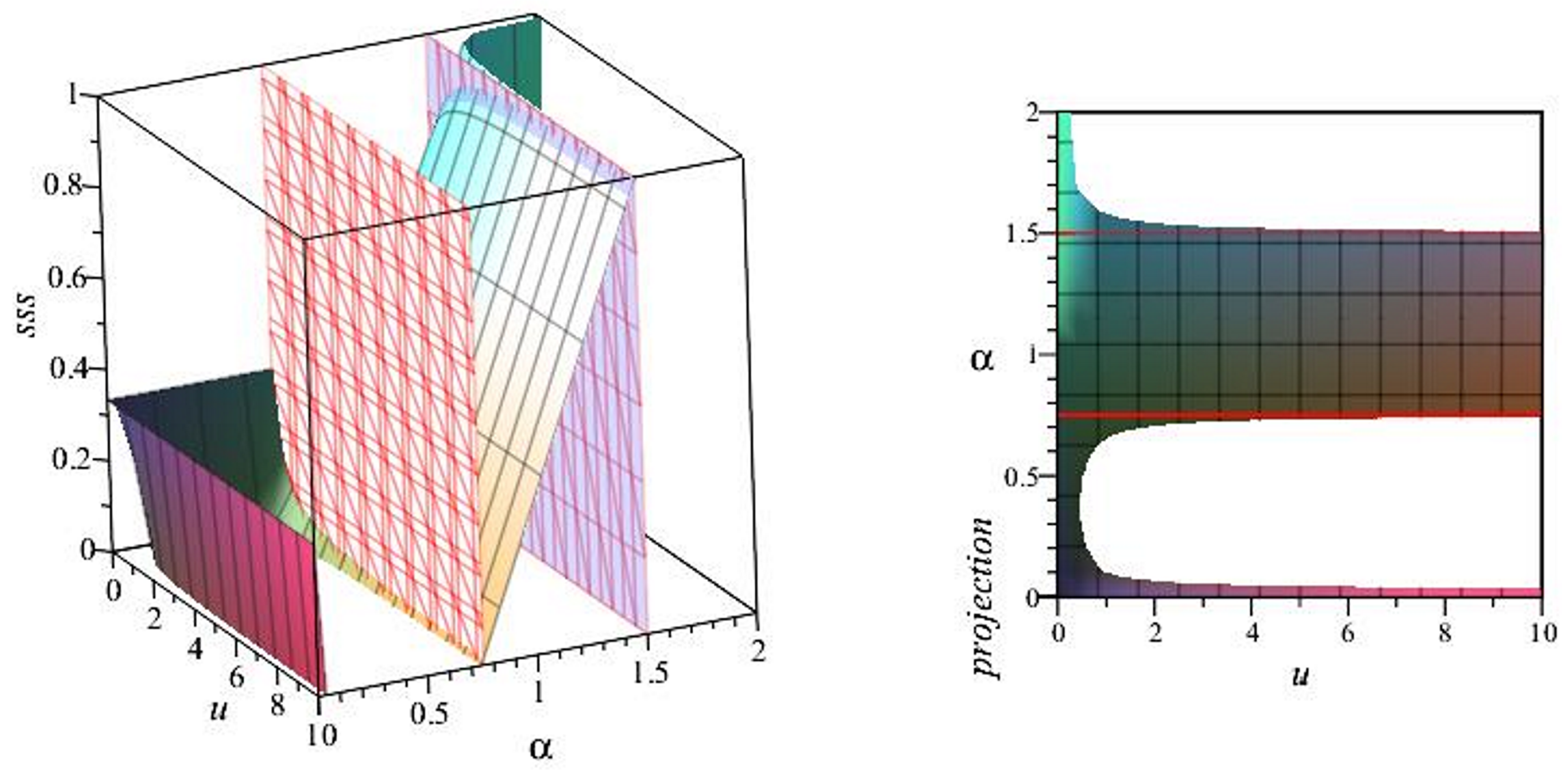
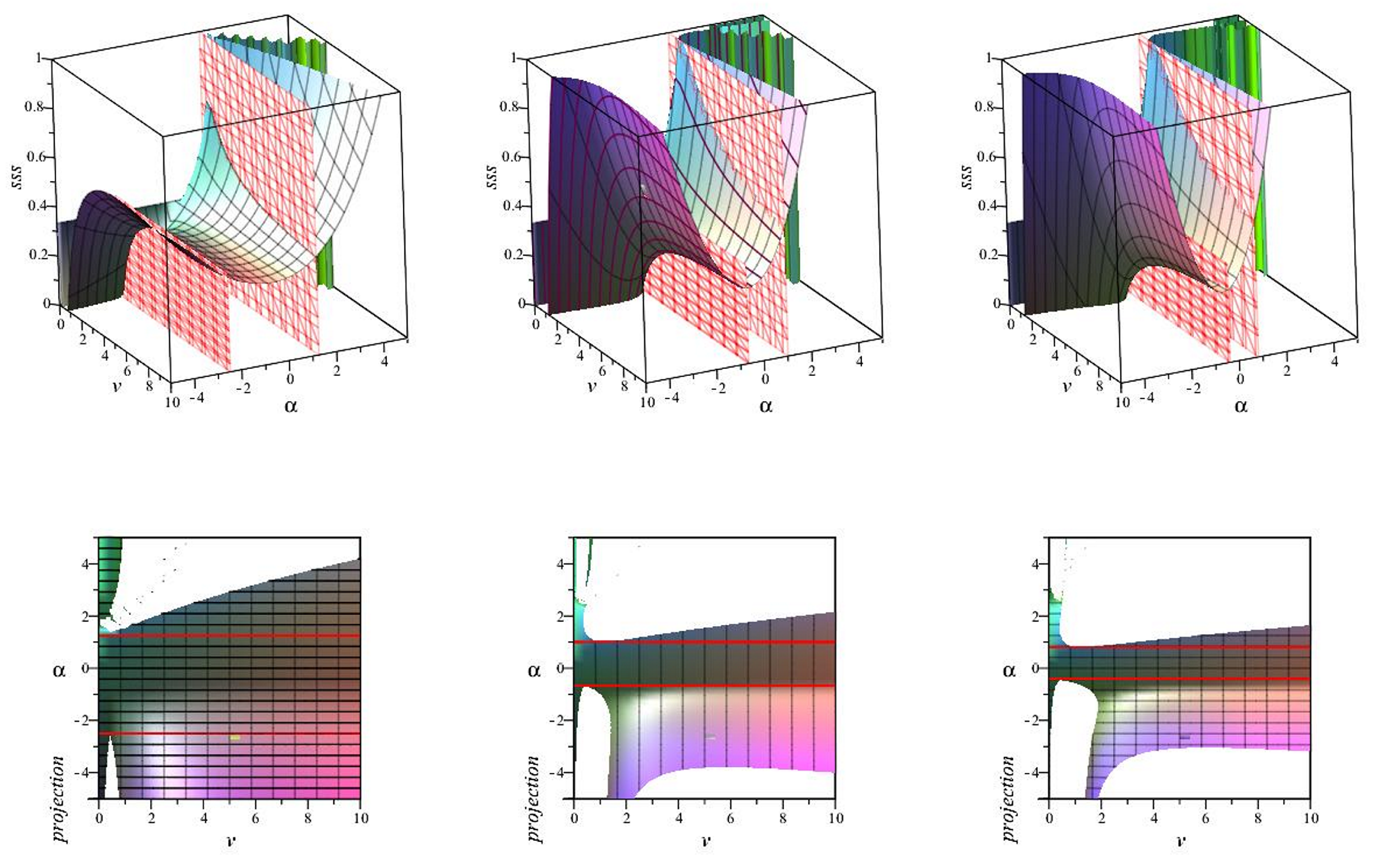
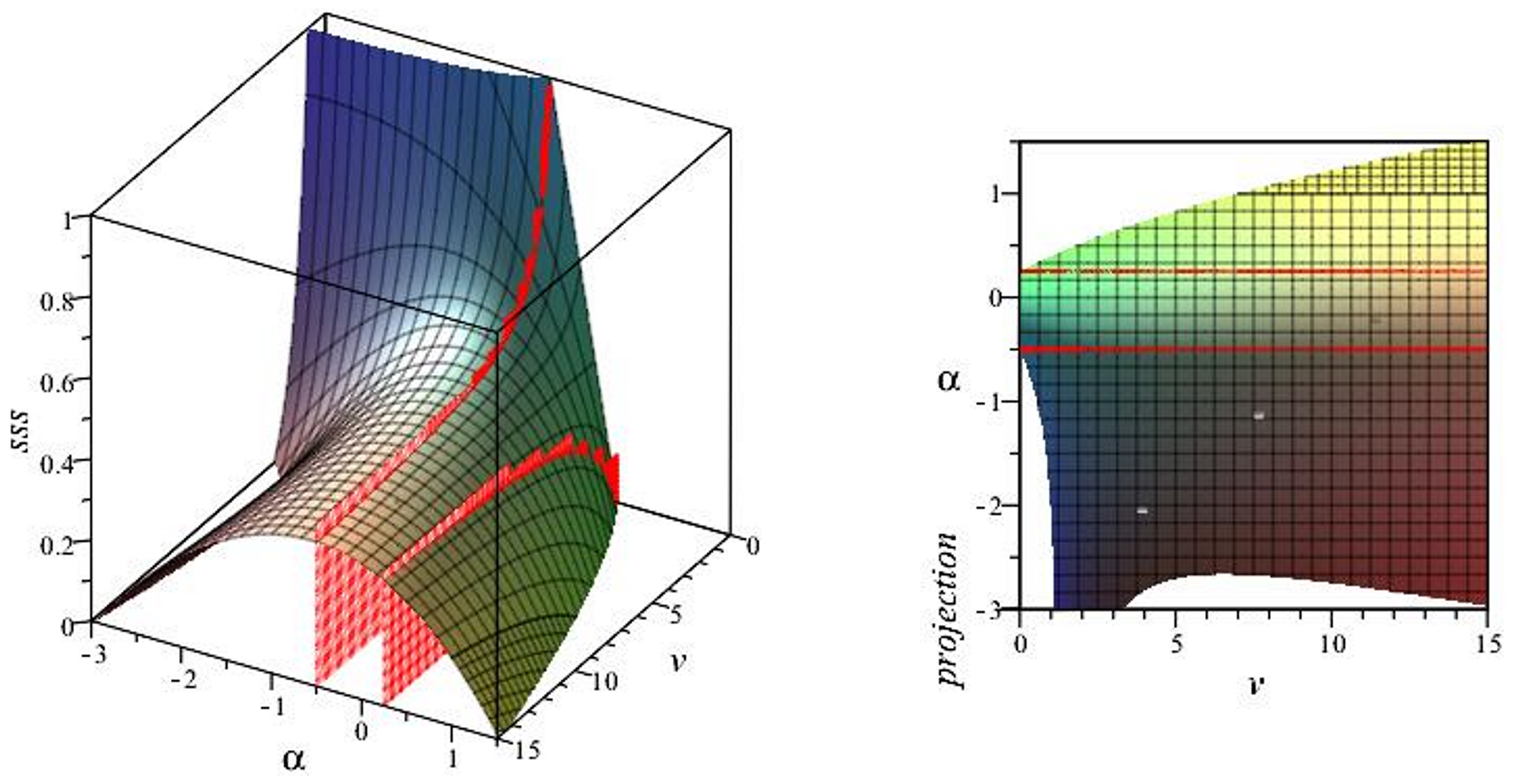
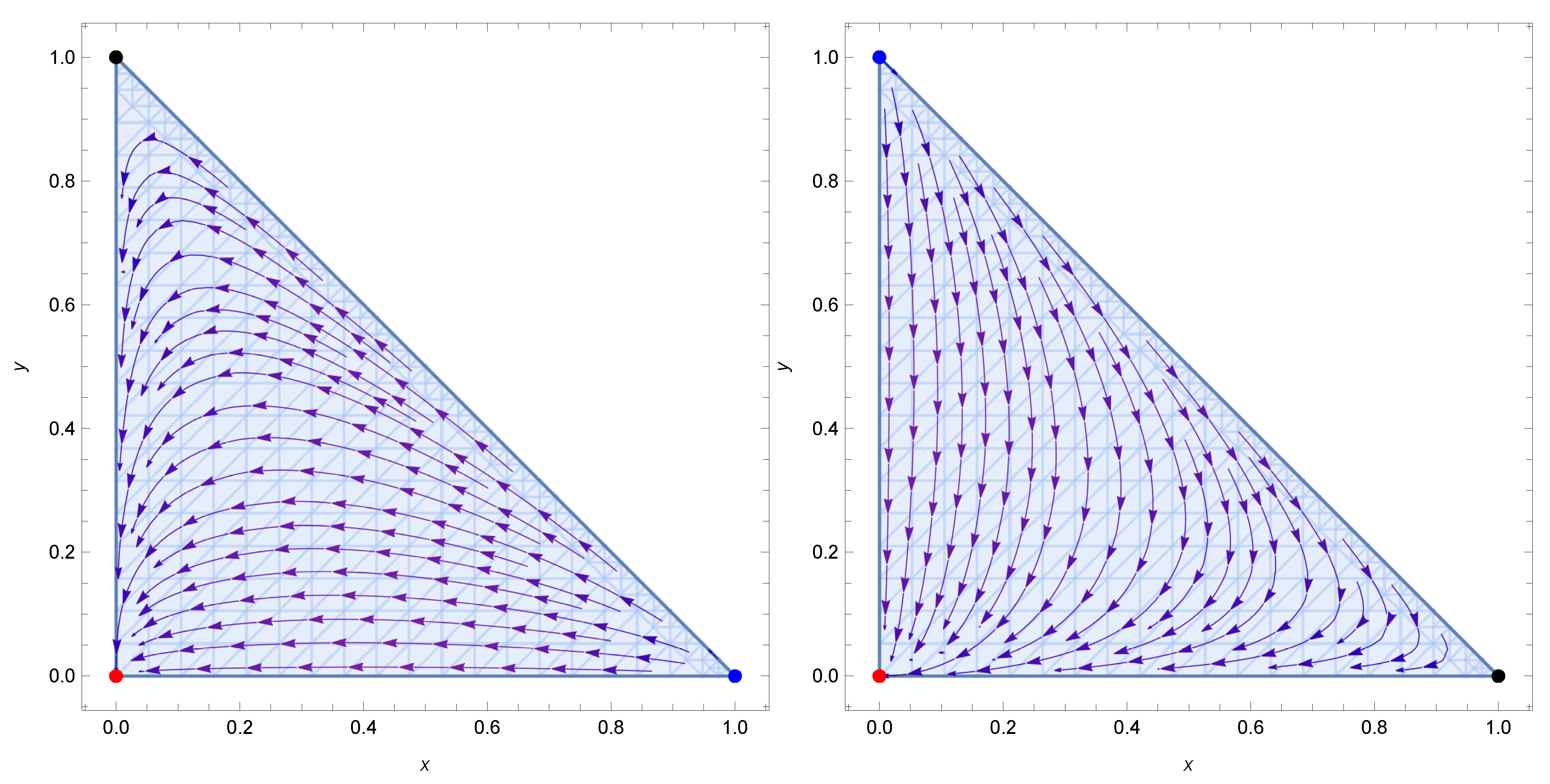
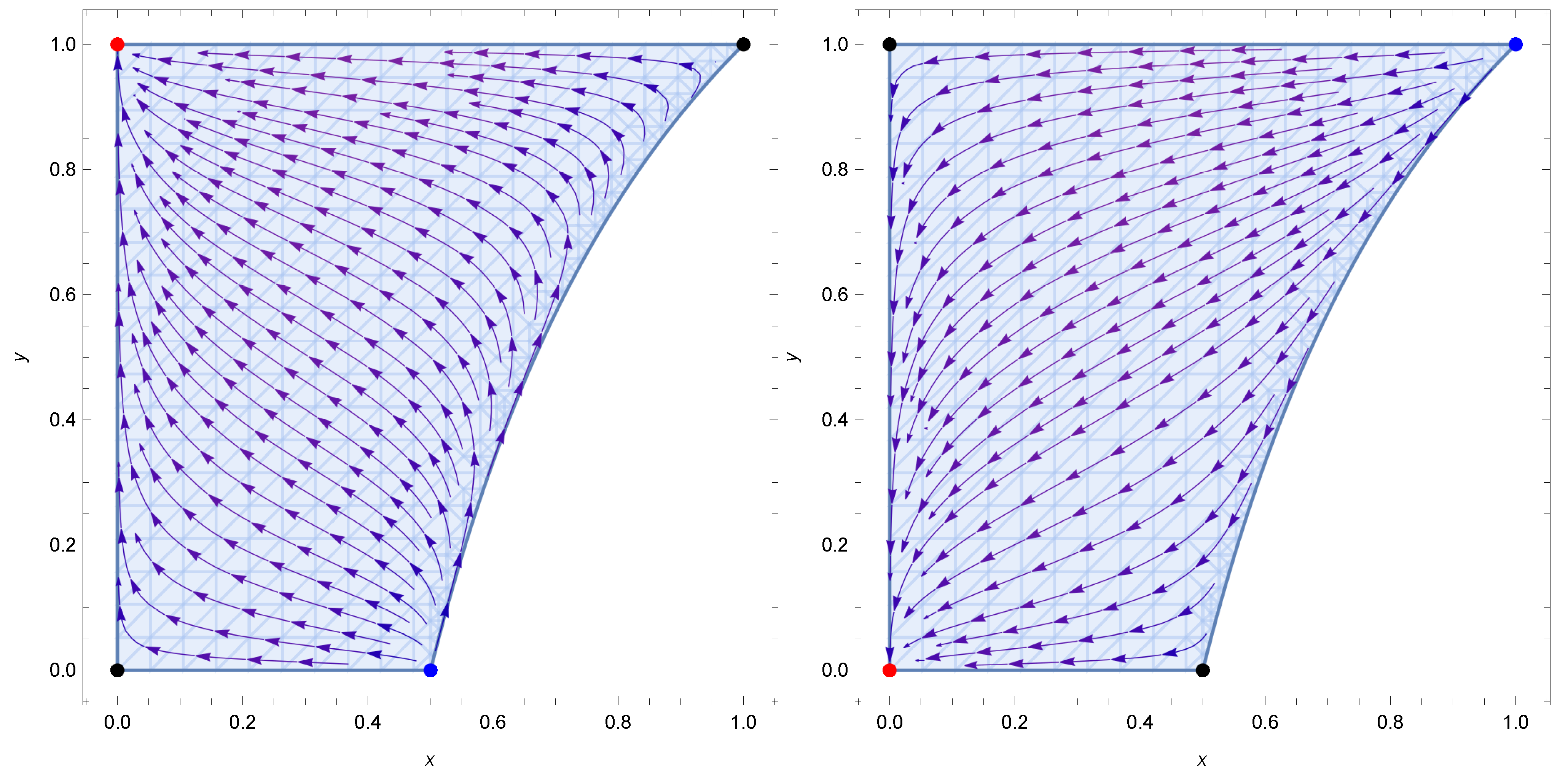
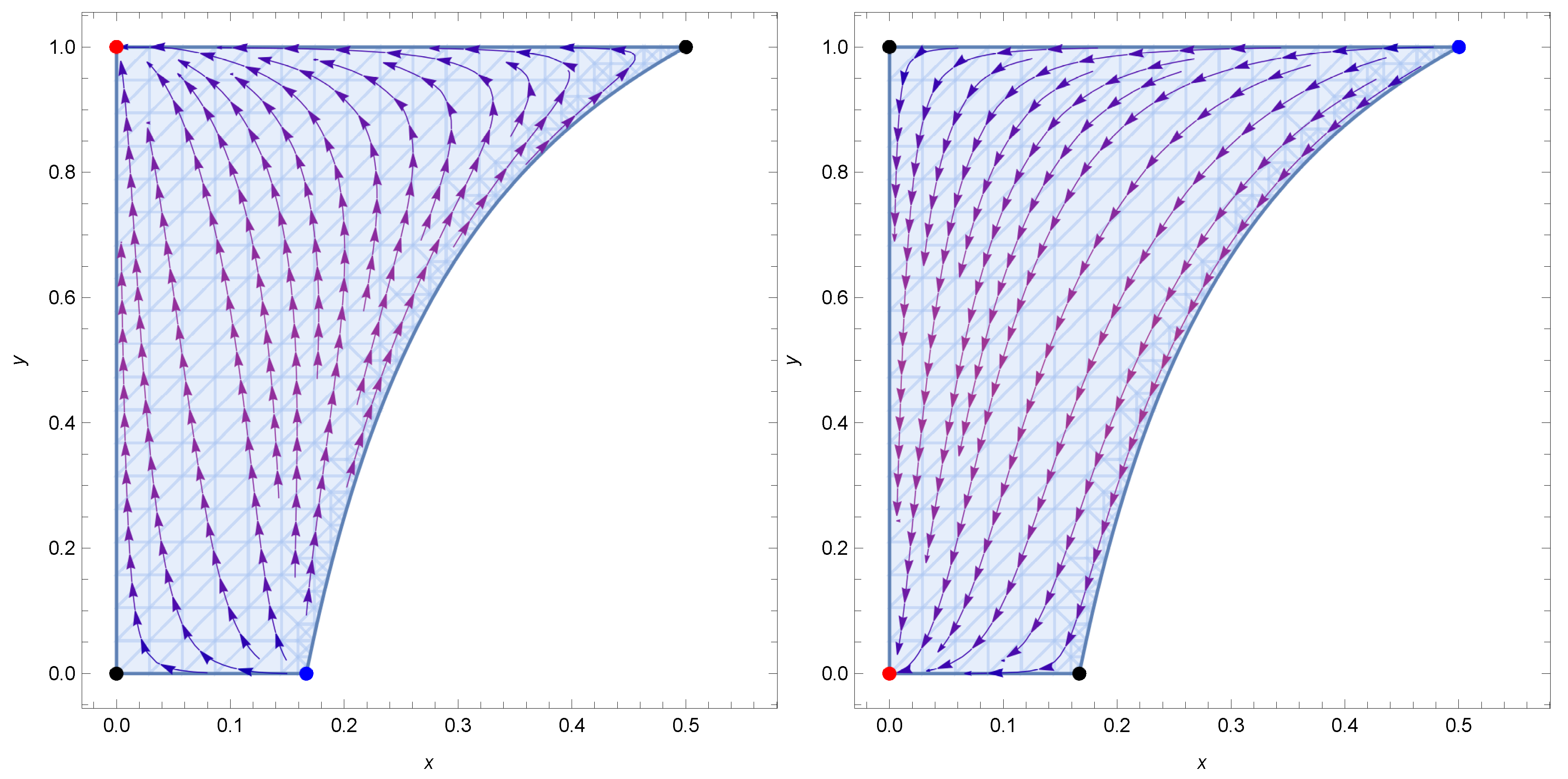
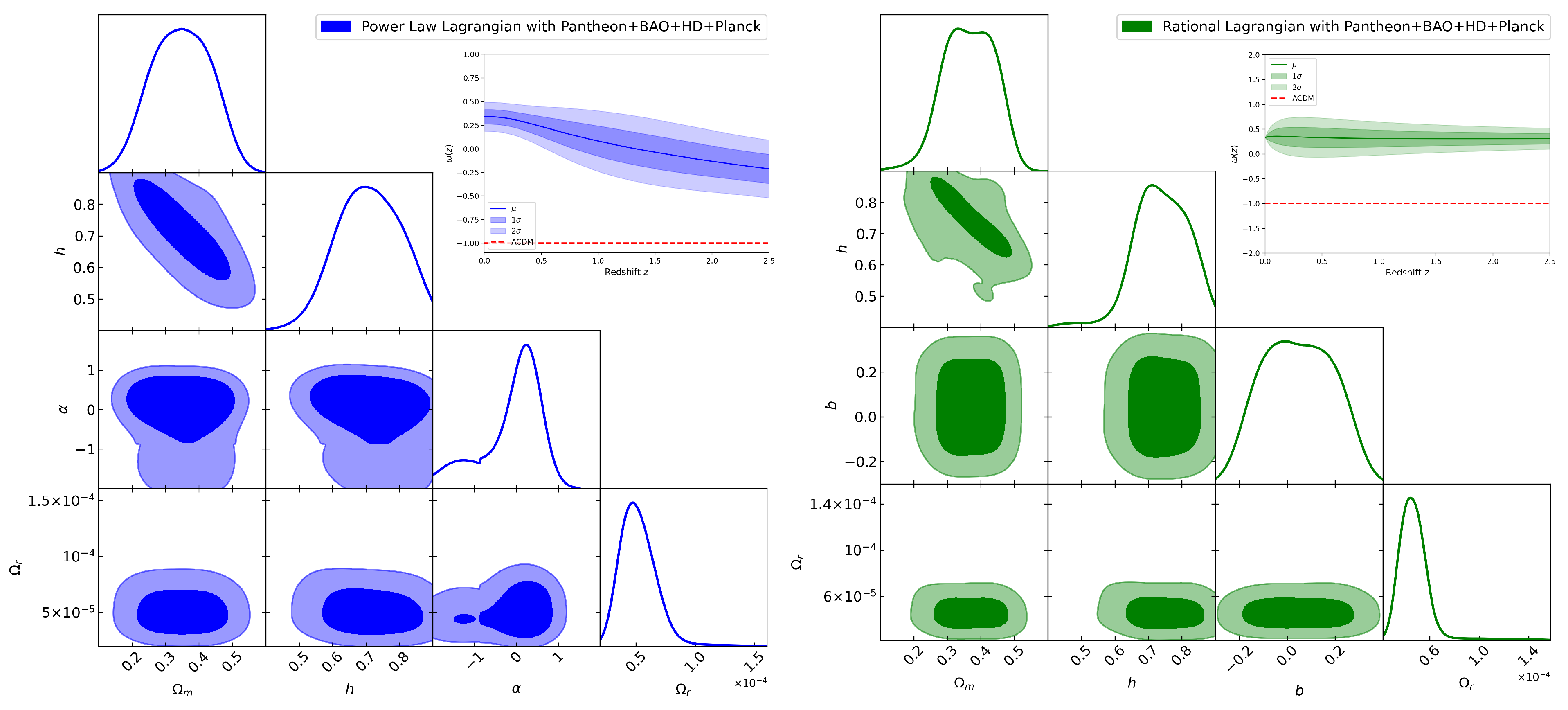
| Power Law | Rational | CDM | |
|---|---|---|---|
| h | |||
| – | – | ||
| b | – | – | |
| with CDM | – | ||
| Evidence over CDM | Very strong in favor of CDM | Very strong in favor of CDM | – |
Disclaimer/Publisher’s Note: The statements, opinions and data contained in all publications are solely those of the individual author(s) and contributor(s) and not of MDPI and/or the editor(s). MDPI and/or the editor(s) disclaim responsibility for any injury to people or property resulting from any ideas, methods, instructions or products referred to in the content. |
© 2024 by the authors. Licensee MDPI, Basel, Switzerland. This article is an open access article distributed under the terms and conditions of the Creative Commons Attribution (CC BY) license (https://creativecommons.org/licenses/by/4.0/).
Share and Cite
García-Salcedo, R.; Gómez-Vargas, I.; González, T.; Martinez-Badenes, V.; Quiros, I. Combined Studies Approach to Rule Out Cosmological Models Which Are Based on Nonlinear Electrodynamics. Universe 2024, 10, 353. https://doi.org/10.3390/universe10090353
García-Salcedo R, Gómez-Vargas I, González T, Martinez-Badenes V, Quiros I. Combined Studies Approach to Rule Out Cosmological Models Which Are Based on Nonlinear Electrodynamics. Universe. 2024; 10(9):353. https://doi.org/10.3390/universe10090353
Chicago/Turabian StyleGarcía-Salcedo, Ricardo, Isidro Gómez-Vargas, Tame González, Vicent Martinez-Badenes, and Israel Quiros. 2024. "Combined Studies Approach to Rule Out Cosmological Models Which Are Based on Nonlinear Electrodynamics" Universe 10, no. 9: 353. https://doi.org/10.3390/universe10090353








